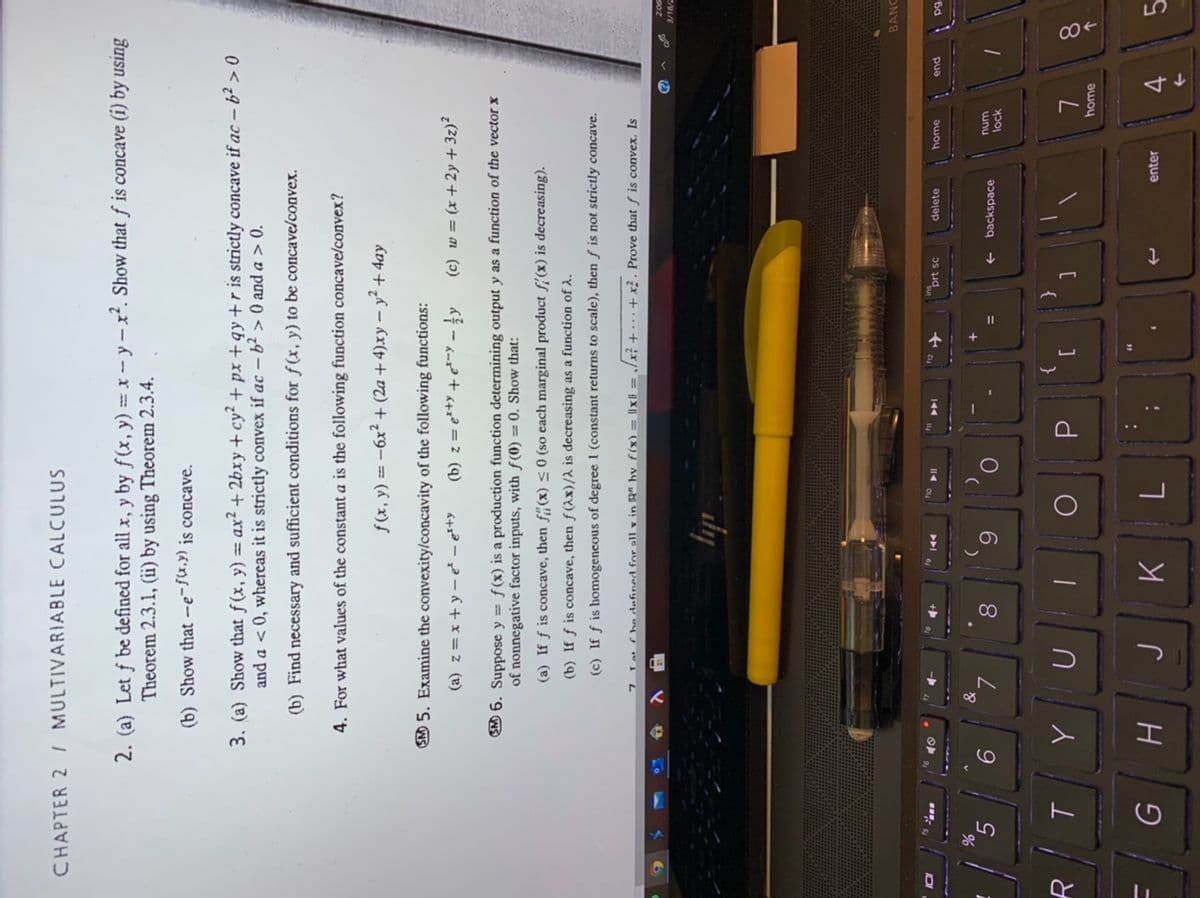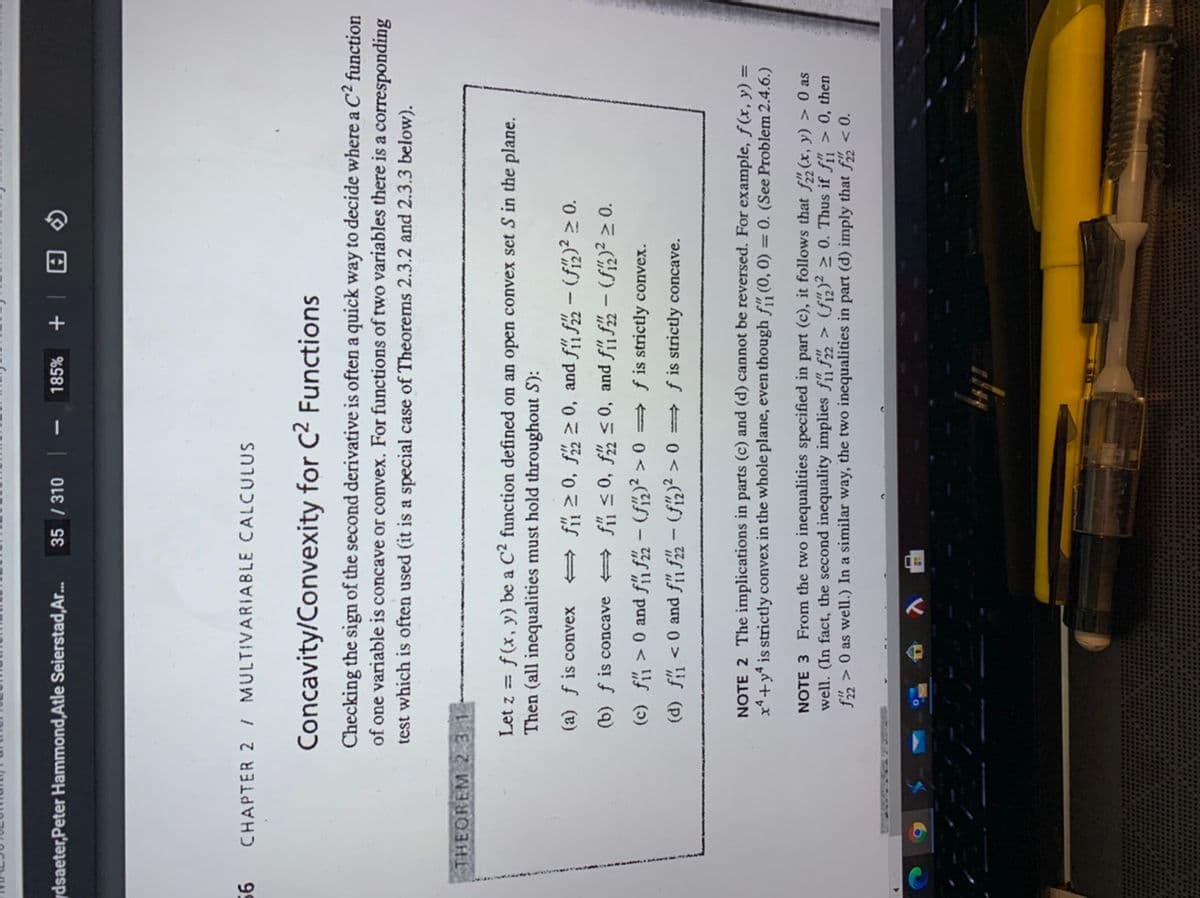2. (a) Let f be defined for all x, y by f(x, y) x-y - x. Show that f is concave (i) by using Theorem 2.3.1, (ii) by using Theorem 2.3.4.
2. (a) Let f be defined for all x, y by f(x, y) x-y - x. Show that f is concave (i) by using Theorem 2.3.1, (ii) by using Theorem 2.3.4.
Algebra & Trigonometry with Analytic Geometry
13th Edition
ISBN:9781133382119
Author:Swokowski
Publisher:Swokowski
Chapter7: Analytic Trigonometry
Section7.6: The Inverse Trigonometric Functions
Problem 91E
Related questions
Topic Video
Question
Can you help with question 2? I attached a picture of the theorem to use.

Transcribed Image Text:..
CHAPTER 2I MULTIVARIABLE CALCULUS
2. (a) Let f be defined for all x, y by f(x, y) x-y - x². Show that f is concave (i) by using
Theorem 2.3.1, (ii) by using Theorem 2.3.4.
(b) Show that -e-Ju.y) is concave.
3. (a) Show that f (x, y) = axr² + 2bxy + cy² + px +qy+r is strictly concave if ac – b² > 0
and a < 0, whereas it is strictly convex if ac - b? > 0 and a > 0.
(b) Find necessary and sufficient conditions for f(x, y) to be concave/convex.
4. For what values of the constant a is the following function concave/convex?
f(x, y) =-6x²+ (2a + 4)xy – y² + 4ay
SM 5. Examine the convexity/concavity of the following functions:
á+x³ – ,? – 6 + x = 2 (x)
(b) z = e*+y + e*=y - }y
(c) w = (x+ 2y + 3z)²
SM 6. Suppose y = f(x) is a production function determining output y as a function of the vector x
of nonnegative factor inputs, with f(0) = 0. Show that:
(a) If f is concave, then f(x) <0 (so each marginal product f{(x) is decreasing).
(b) If f is concave, then f (Ax)/A is decreasing as a function of 2.
(c) If f is homogeneous of degree 1 (constant returns to scale), then f is not strictly concave.
Tat f he defined for all v in R" by f(x) = |x H =./x +...+x². Prove that f is convex. Is
902
BANG
prt sc
delete
home
pua
Bd
wnu
lock
->
backspace
8
[
home
enter
4.
->

Transcribed Image Text:ydsaeter,Peter Hammond,Atle Seierstad,Ar..
35 / 310
185%
+
99
CHAPTER 2 I MULTIVARIABLE CALCULUS
Concavity/Convexity for C2 Functions
Checking the sign of the second derivative is often a quick way to decide where a C2 function
of one variable is concave or convex. For functions of two variables there is a corresponding
test which is often used (it is a special case of Theorems 2.3.2 and 2.3.3 below).
THEOREM 2-3,1
Let z = f (x, y) be a C² function defined on an open convex set S in the plane.
Then (all inequalities must hold throughout S):
(a) ƒ is convex
A f 2 0, fm 2 0, and fij fn - (f)? > 0.
(b) f is concave - fi s0, f s0, and fi f- (S)? > 0.
(c) f > 0 and f, fm- (f)? > 0 f is strictly convex.
(d) f < 0 and fi fm- (f)² > 0 = f is strictly concave.
NOTE 2 The implications in parts (c) and (d) cannot be reversed. For example, f (x, y) =
x*+y* is strictly convex in the whole plane, even though f (0, 0) = 0. (See Problem 2.4.6.)
NOTE 3 From the two inequalities specified in part (c), it follows that f (x, y) > 0 as
well. (In fact, the second inequality implies fi f2 > (f2)² > 0. Thus if fi > 0, then
f2 > 0 as well.) In a similar way, the two inequalities in part (d) imply that f < 0.
MARUGK A R
Expert Solution
This question has been solved!
Explore an expertly crafted, step-by-step solution for a thorough understanding of key concepts.
This is a popular solution!
Trending now
This is a popular solution!
Step by step
Solved in 2 steps

Knowledge Booster
Learn more about
Need a deep-dive on the concept behind this application? Look no further. Learn more about this topic, advanced-math and related others by exploring similar questions and additional content below.Recommended textbooks for you

Algebra & Trigonometry with Analytic Geometry
Algebra
ISBN:
9781133382119
Author:
Swokowski
Publisher:
Cengage

College Algebra (MindTap Course List)
Algebra
ISBN:
9781305652231
Author:
R. David Gustafson, Jeff Hughes
Publisher:
Cengage Learning

Linear Algebra: A Modern Introduction
Algebra
ISBN:
9781285463247
Author:
David Poole
Publisher:
Cengage Learning

Algebra & Trigonometry with Analytic Geometry
Algebra
ISBN:
9781133382119
Author:
Swokowski
Publisher:
Cengage

College Algebra (MindTap Course List)
Algebra
ISBN:
9781305652231
Author:
R. David Gustafson, Jeff Hughes
Publisher:
Cengage Learning

Linear Algebra: A Modern Introduction
Algebra
ISBN:
9781285463247
Author:
David Poole
Publisher:
Cengage Learning
